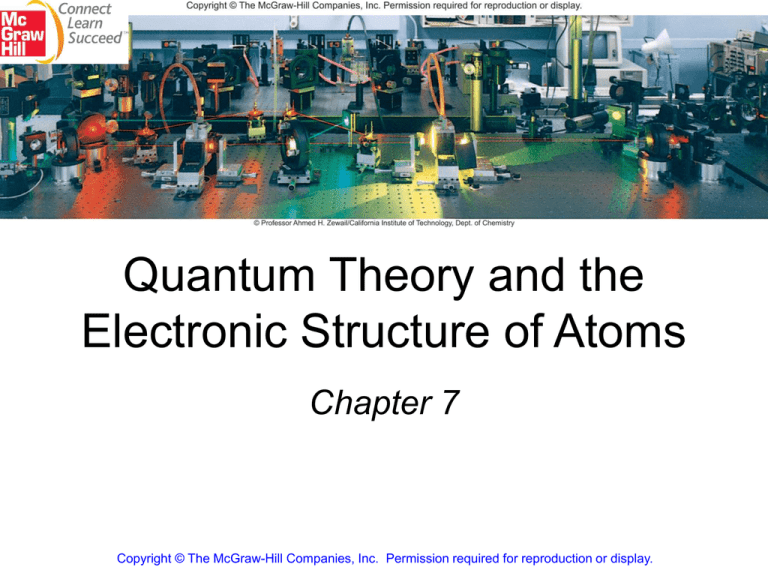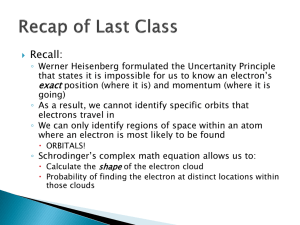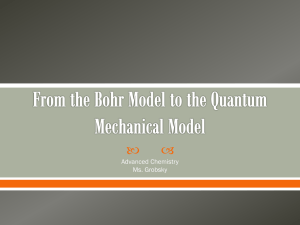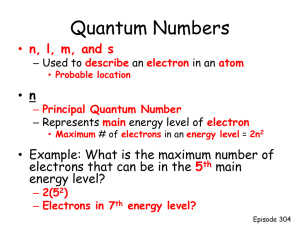Chapter_7_Electronic_Structure_of_Atoms
advertisement

Quantum Theory and the Electronic Structure of Atoms Chapter 7 1 Copyright © The McGraw-Hill Companies, Inc. Permission required for reproduction or display. Properties of Waves Wavelength (l) is the distance between identical points on successive waves. Amplitude is the vertical distance from the midline of a wave to the peak or trough. Frequency (n) is the number of waves that pass through a particular point in 1 second (Hz = 1 cycle/s). The speed (u) of the wave = l x n 2 Maxwell (1873), proposed that visible light consists of electromagnetic waves. Electromagnetic radiation is the emission and transmission of energy in the form of electromagnetic waves. Speed of light (c) in vacuum = 3.00 x 108 m/s All electromagnetic radiation lxn=c 3 Example 7.1 The wavelength of the green light from a traffic signal is centered at 522 nm. What is the frequency of this radiation? Example 7.1 Strategy We are given the wavelength of an electromagnetic wave and asked to calculate its frequency. Rearranging Equation (7.1) and replacing u with c (the speed of light) gives Solution Because the speed of light is given in meters per second, it is convenient to first convert wavelength to meters. Recall that 1 nm = 1 × 10−9 m (see Table 1.3). We write Example 7.1 Substituting in the wavelength and the speed of light (3.00 × 108 m/s), the frequency is Check The answer shows that 5.75 × 1014 waves pass a fixed point every second. This very high frequency is in accordance with the very high speed of light. 7 Mystery #1, “Heated Solids Problem” Solved by Planck in 1900 When solids are heated, they emit electromagnetic radiation over a wide range of wavelengths. Radiant energy emitted by an object at a certain temperature depends on its wavelength. Energy (light) is emitted or absorbed in discrete units (quantum). E=hxn Planck’s constant (h) h = 6.63 x 10-34 J•s 8 Mystery #2, “Photoelectric Effect” Solved by Einstein in 1905 hn Light has both: 1. wave nature 2. particle nature KE e- Photon is a “particle” of light hn = KE + W KE = hn - W where W is the work function and depends how strongly electrons are held in the metal 9 Example 7.2 Calculate the energy (in joules) of (a) a photon with a wavelength of 5.00 × 104 nm (infrared region) (b) a photon with a wavelength of 5.00 × 10−2 nm (X ray region) Example 7.2 Strategy In both (a) and (b) we are given the wavelength of a photon and asked to calculate its energy. We need to use Equation (7.3) to calculate the energy. Planck’s constant is given in the text and also on the back inside cover. Example 7.2 Solution (a) From Equation (7.3), This is the energy of a single photon with a 5.00 × 104 nm wavelength. Example 7.2 (b) Following the same procedure as in (a), we can show that the energy of the photon that has a wavelength of 5.00 × 10−2 nm is 3.98 × 10−15 J . Check Because the energy of a photon increases with decreasing wavelength, we see that an “X-ray” photon is 1 × 106, or a million times more energetic than an “infrared” photon. Example 7.3 The work function of cesium metal is 3.42 × 10−19 J. (a) Calculate the minimum frequency of light required to release electrons from the metal. (b) Calculate the kinetic energy of the ejected electron if light of frequency 1.00 × 1015 s−1 is used for irradiating the metal. Example 7.3 Strategy (a) The relationship between the work function of an element and the frequency of light is given by Equation (7.4). The minimum frequency of light needed to dislodge an electron is the point where the kinetic energy of the ejected electron is zero. (b) Knowing both the work function and the frequency of light, we can solve for the kinetic energy of the ejected electron. Example 7.3 Solution (a) Setting KE = 0 in Equation (7.4), we write hn = W Thus, Check The kinetic energy of the ejected electron (3.21×10−19 J) is smaller than the energy of the photon (6.63×10−19 J). Therefore, the answer is reasonable. Line Emission Spectrum of Hydrogen Atoms 17 18 Bohr’s Model of the Atom (1913) 1. e- can only have specific (quantized) energy values 2. light is emitted as emoves from one energy level to a lower energy level En = -RH ( 1 n2 ) n (principal quantum number) = 1,2,3,… RH (Rydberg constant) = 2.18 x 10-18J 19 E = hn E = hn 20 Ephoton = DE = Ef - Ei ni = 3 ni = 3 ni = 2 nf = 2 1 Ef = -RH ( 2 nf 1 Ei = -RH ( 2 ni 1 DE = RH( 2 ni ) ) 1 n2f nnf f==11 21 ) 22 Example 7.4 What is the wavelength of a photon (in nanometers) emitted during a transition from the ni = 5 state to the nf = 2 state in the hydrogen atom? Example 7.4 Strategy We are given the initial and final states in the emission process. We can calculate the energy of the emitted photon using Equation (7.6). Then from Equations (7.2) and (7.1) we can solve for the wavelength of the photon. The value of Rydberg’s constant is given in the text. Example 7.4 Solution From Equation (7.6) we write The negative sign indicates that this is energy associated with an emission process. To calculate the wavelength, we will omit the minus sign for DE because the wavelength of the photon must be positive. Example 7.4 Because DE = hn or n = DE/h, we can calculate the wavelength of the photon by writing Example 7.4 Check The wavelength is in the visible region of the electromagnetic region (see Figure 7.4). This is consistent with the fact that because nf = 2, this transition gives rise to a spectral line in the Balmer series (see Figure 7.6). Chemistry in Action: Laser – The Splendid Light Laser light is (1) intense, (2) monoenergetic, and (3) coherent 28 Why is e- energy quantized? De Broglie (1924) reasoned that e- is both particle and wave. 2pr = nl h l = mu u = velocity of em = mass of e29 Example 7.5 Example 7.5 Strategy We are given the mass and the speed of the particle in (a) and (b) and asked to calculate the wavelength so we need Equation (7.8). Note that because the units of Planck’s constants are J · s, m and u must be in kg and m/s (1 J = 1 kg m2/s2), respectively. Example 7.5 Solution (a) Using Equation (7.8) we write Comment This is an exceedingly small wavelength considering that the size of an atom itself is on the order of 1 × 10−10 m. For this reason, the wave properties of a tennis ball cannot be detected by any existing measuring device. Example 7.5 (b) In this case, Comment This wavelength (1.1 × 10−5 m or 1.1 × 104 nm) is in the infrared region. This calculation shows that only electrons (and other submicroscopic particles) have measurable wavelengths. Chemistry in Action: Electron Microscopy le = 0.004 nm Electron micrograph of a normal red blood cell and a sickled red blood cell from the same person STM image of iron atoms on copper surface 34 Example 7.6 (a) An electron is moving at a speed of 8.0 × 106 m/s. If the uncertainty in measuring the speed is 1.0 percent of the speed, calculate the uncertainty in the electron’s position. The mass of the electron is 9.1094 × 10−31 kg. (b) A baseball of mass 0.15 kg thrown at 100 mph has a momentum of 6.7 kg · m/s. If the uncertainty in measuring this momentum is 1.0 × 10−7 of the momentum, calculate the uncertainty in the baseball’s position. Example 7.6 Strategy To calculate the minimum uncertainty in both (a) and (b), we use an equal sign in Equation (7.9). Solution (a) The uncertainty in the electron’s speed u is Momentum (p) is p = mu, so that Example 7.6 From Equation (7.9), the uncertainty in the electron’s position is This uncertainty corresponds to about 4 atomic diameters. Example 7.6 (b) The uncertainty in the position of the baseball is This is such a small number as to be of no consequence, that is, there is practically no uncertainty in determining the position of the baseball in the macroscopic world. Schrodinger Wave Equation In 1926 Schrodinger wrote an equation that described both the particle and wave nature of the eWave function (y) describes: 1. energy of e- with a given y 2. probability of finding e- in a volume of space Schrodinger’s equation can only be solved exactly for the hydrogen atom. Must approximate its solution for multi-electron systems. 39 Schrodinger Wave Equation y is a function of four numbers called quantum numbers (n, l, ml, ms) principal quantum number n n = 1, 2, 3, 4, …. distance of e- from the nucleus n=1 n=2 n=3 40 Schrodinger Wave Equation quantum numbers: (n, l, ml, ms) angular momentum quantum number l for a given value of n, l = 0, 1, 2, 3, … n-1 n = 1, l = 0 n = 2, l = 0 or 1 n = 3, l = 0, 1, or 2 l=0 l=1 l=2 l=3 s orbital p orbital d orbital f orbital Shape of the “volume” of space that the e- occupies 41 Schrodinger Wave Equation quantum numbers: (n, l, ml, ms) magnetic quantum number ml for a given value of l ml = -l, …., 0, …. +l if l = 1 (p orbital), ml = -1, 0, or 1 if l = 2 (d orbital), ml = -2, -1, 0, 1, or 2 orientation of the orbital in space 42 Schrodinger Wave Equation (n, l, ml, ms) spin quantum number ms ms = +½ or -½ ms = +½ ms = -½ 43 44 Where 90% of the e- density is found for the 1s orbital 45 l = 0 (s orbitals) l = 1 (p orbitals) 46 l = 2 (d orbitals) 47 Example 7.7 List the values of n, ℓ, and mℓ for orbitals in the 4d subshell. Example 7.7 Strategy What are the relationships among n, ℓ, and mℓ? What do “4” and “d” represent in 4d? Solution As we saw earlier, the number given in the designation of the subshell is the principal quantum number, so in this case n = 4. The letter designates the type of orbital. Because we are dealing with d orbitals, ℓ = 2. The values of mℓ can vary from −ℓ to ℓ. Therefore, mℓ can be −2, −1, 0, 1, or 2. Check The values of n and ℓ are fixed for 4d, but mℓ can have any one of the five values, which correspond to the five d orbitals. ml = -1, 0, or 1 3 orientations is space 50 ml = -2, -1, 0, 1, or 2 5 orientations is space 51 Example 7.8 What is the total number of orbitals associated with the principal quantum number n = 3? Example 7.8 Strategy To calculate the total number of orbitals for a given n value, we need to first write the possible values of ℓ. We then determine how many mℓ values are associated with each value of ℓ. The total number of orbitals is equal to the sum of all the mℓ values. Solution For n = 3, the possible values of ℓ are 0, 1, and 2. Thus, there is one 3s orbital (n = 3, ℓ = 0, and mℓ = 0); there are three 3p orbitals (n = 3, ℓ = 1, and mℓ = −1, 0, 1); there are five 3d orbitals (n = 3, ℓ = 2, and mℓ = −2, −1, 0, 1, 2). The total number of orbitals is 1 + 3 + 5 = 9. Check The total number of orbitals for a given value of n is n2. So here we have 32 = 9. Can you prove the validity of this relationship? Schrodinger Wave Equation quantum numbers: (n, l, ml, ms) Existence (and energy) of electron in atom is described by its unique wave function y. Pauli exclusion principle - no two electrons in an atom can have the same four quantum numbers. Each seat is uniquely identified (E, R12, S8). Each seat can hold only one individual at a time. 54 Schrodinger Wave Equation quantum numbers: (n, l, ml, ms) Shell – electrons with the same value of n Subshell – electrons with the same values of n and l Orbital – electrons with the same values of n, l, and ml 55 Energy of orbitals in a single electron atom Energy only depends on principal quantum number n n=3 n=2 En = -RH ( 1 n2 ) n=1 56 Energy of orbitals in a multi-electron atom Energy depends on n and l n=3 l = 2 n=3 l = 0 n=2 l = 0 n=3 l = 1 n=2 l = 1 n=1 l = 0 57 “Fill up” electrons in lowest energy orbitals (Aufbau principle) 58 The most stable arrangement of electrons in subshells is the one with the greatest number of parallel spins (Hund’s rule). 59 Order of orbitals (filling) in multi-electron atom 1s < 2s < 2p < 3s < 3p < 4s < 3d < 4p < 5s < 4d < 5p < 6s 60 Example 7.9 Write the four quantum numbers for an electron in a 3p orbital. Example 7.9 Strategy What do the “3” and “p” designate in 3p? How many orbitals (values of mℓ) are there in a 3p subshell? What are the possible values of electron spin quantum number? Solution To start with, we know that the principal quantum number n is 3 and the angular momentum quantum number ℓ must be 1 (because we are dealing with a p orbital). For ℓ = 1, there are three values of mℓ given by −1, 0, and 1. Because the electron spin quantum number ms can be either +½ or −½, we conclude that there are six possible ways to designate the electron using the (n, ℓ , mℓ, ms) notation. Example 7.9 These are: Check In these six designations we see that the values of n and ℓ are constant, but the values of mℓ and ms can vary. Electron configuration is how the electrons are distributed among the various atomic orbitals in an atom. number of electrons in the orbital or subshell 1s1 principal quantum number n angular momentum quantum number l Orbital diagram H 1s1 64 Paramagnetic unpaired electrons 2p Diamagnetic all electrons paired 2p 65 Example 7.10 What is the maximum number of electrons that can be present in the principal level for which n = 3? Example 7.10 Strategy We are given the principal quantum number (n) so we can determine all the possible values of the angular momentum quantum number (ℓ). The preceding rule shows that the number of orbitals for each value of ℓ is (2 ℓ + 1). Thus, we can determine the total number of orbitals. How many electrons can each orbital accommodate? Solution When n = 3, ℓ = 0, 1, and 2. The number of orbitals for each value of ℓ is given by Example 7.10 The total number of orbitals is nine. Because each orbital can accommodate two electrons, the maximum number of electrons that can reside in the orbitals is 2 × 9, or 18. Check If we use the formula (n2) in Example 7.8, we find that the total number of orbitals is 32 and the total number of electrons is 2(32) or 18. In general, the number of electrons in a given principal energy level n is 2n2. Example 7.11 An oxygen atom has a total of eight electrons. Write the four quantum numbers for each of the eight electrons in the ground state. Example 7.11 Strategy We start with n = 1 and proceed to fill orbitals in the order shown in Figure 7.24. For each value of n we determine the possible values of ℓ. For each value of ℓ, we assign the possible values of mℓ. We can place electrons in the orbitals according to the Pauli exclusion principle and Hund’s rule. Example 7.11 Solution We start with n = 1, so ℓ = 0, a subshell corresponding to the 1s orbital. This orbital can accommodate a total of two electrons. Next, n = 2, and / may be either 0 or 1. The ℓ = 0 subshell contains one 2s orbital, which can accommodate two electrons. The remaining four electrons are placed in the ℓ = 1 subshell, which contains three 2p orbitals. The orbital diagram is Example 7.11 The results are summarized in the following table: Of course, the placement of the eighth electron in the orbital labeled mℓ = 1 is completely arbitrary. It would be equally correct to assign it to mℓ = 0 or mℓ = −1. 73 Outermost subshell being filled with electrons 74 Example 7.12 Write the ground-state electron configurations for (a) sulfur (S) (b) palladium (Pd), which is diamagnetic. Example 7.12 (a) Strategy How many electrons are in the S (Z = 16) atom? We start with n = 1 and proceed to fill orbitals in the order shown in Figure 7.24. For each value of ℓ, we assign the possible values of mℓ. We can place electrons in the orbitals according to the Pauli exclusion principle and Hund’s rule and then write the electron configuration. The task is simplified if we use the noble-gas core preceding S for the inner electrons. Solution Sulfur has 16 electrons. The noble gas core in this case is [Ne]. (Ne is the noble gas in the period preceding sulfur.) [Ne] represents 1s22s22p6. This leaves us 6 electrons to fill the 3s subshell and partially fill the 3p subshell. Thus, the electron configuration of S is 1s22s22p63s23p4 or [Ne]3s23p4 . Example 7.12 (b) Strategy We use the same approach as that in (a). What does it mean to say that Pd is a diamagnetic element? Solution Palladium has 46 electrons. The noble-gas core in this case is [Kr]. (Kr is the noble gas in the period preceding palladium.) [Kr] represents 1s22s22p63s23p64s23d104p6 The remaining 10 electrons are distributed among the 4d and 5s orbitals. The three choices are (1) 4d10, (2) 4d95s1, and (3) 4d85s2. Example 7.12 Because palladium is diamagnetic, all the electrons are paired and its electron configuration must be 1s22s22p63s23p64s23d104p64d10 or simply [Kr]4d10 . The configurations in (2) and (3) both represent paramagnetic elements. Check To confirm the answer, write the orbital diagrams for (1), (2), and (3).







